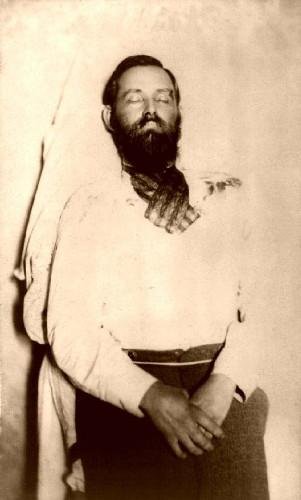Jesse had a very bad day
jmp.press@gmail.com
Mark Powell is on family leave. This column is reprinted from March 2016.
April 3, 1882 was a bad day for Jesse James. A very bad day, in fact.
I’ve always been …
This item is available in full to subscribers.
Subscribe to continue reading. Already a subscriber? Sign in
Get 50% of all subscriptions for a limited time. Subscribe today.
Please log in to continueNeed an account?
|
Jesse had a very bad day
jmp.press@gmail.com
Mark Powell is on family leave. This column is reprinted from March 2016.
April 3, 1882 was a bad day for Jesse James. A very bad day, in fact.
I’ve always been intrigued by his shooting. It happened in St. Joseph, Missouri, the city where I was born. St. Joe, which was the eastern terminus of the Pony Express, calls itself the place “where the Pony Express began and Jesse James ended.” My Great-Grandfather Elisha Powell even got a post-mortem peek at the famous outlaw as a 17 year-old boy when the body was on public display … my family’s only connection to that grisly time. (At least, as far as the old folks ever told us. Unpleasant things weren’t talked about back then.)
I don’t have a rosy, romanticized view of Jesse James. He put innocent men in the ground and stole money from innocent people. Murderous thievery, regardless of the motivation, doesn’t make one a hero. Still, there was a sad quality to the way his life ended and an odd poetic justice for the man who dispatched him to the Great Hereafter, too. Let me tell you about it.
The heat was on back in the early spring of 1882, so Jesse and family were laying low in a plain little house on Lafayatte Street in St. Joe. He rented it under the name Mr. Howard, an alias he had used before. The James Gang had fallen on hard times, and Jesse was trying (in modern terminology) to “put the band back together” for a criminal comeback. But with many old members dead or in prison, it was time for new blood.
Brothers Bob and Charley Ford were handsome men in their early 20s. They were also snakes. For while they were worming their way into Jesse James’ world, they were also secretly negotiating with Missouri’s governor for the $5,000 reward on James’ head. A deal was cut: kill James and get the cash, plus a full pardon.
April 3, 1882 was an unusually warm Monday. After finishing breakfast in the little rented house, James noticed a picture was hanging crooked on a wall. With his guns resting on a nearby table, he was straightening it when Bob Ford shot him from behind. Jesse James was no hero; but shooting an unarmed man from behind was the ultimate in cowardice. Conspiring to collect $5,000 for it added a Judas Iscariot dimension, too.
But while Jesse James’ story was over, Bob and Charley Ford’s tale was just beginning. They wired the governor to collect their ill-gotten gain, then turned themselves in to authorities. Imagine their surprise when they were indicted for murder, tried, found guilty and sentenced to hang – in just one day! Two hours later, the governor spared them from the gallows with a full pardon. But he ripped them off on the reward by paying only $500, a far cry from the $5,000 they were promised. (Thievery wasn’t limited to outlaws back then.)
It was all downhill from there for the Brothers Ford. Killing a celebrity made them celebrities, but in a bad way. Bob was viewed much like John Wilkes Booth, who also shot Lincoln from behind. Even people who loathed Jesse James felt he didn’t deserve an ending like that.
Bob and Charley tried to cash in on their new-found fame. Bob posed for pictures in cheap arcades, a forerunner to Pay Per View. The brothers re-enacted the shooting on stage, but the audience’s dislike of them and their inability to act doomed the show. Two years later Charley, riddled with tuberculosis and addicted to morphine because of the pain, committed suicide. Bob Ford stumbled from job to job. He opened a saloon in New Mexico Territory, tried his hand at being a policeman in Las Vegas, and finally wound up in Colorado where he opened another saloon. When it burned down, he reopened in a tent. Then it was on to another saloon in yet another town.
He was working in it on June 8, 1892 when a man walked in and said, “Hello Bob.” As he turned around, Edward O’Kelly fired both barrels of a double barrel shotgun, killing Ford instantly. O’Kelly became known as “The Man who killed the man who killed Jesse James,” until he himself was killed in 1904 while trying to shoot a policeman in Oklahoma City.
And so the bloody string of interconnected killings finally ended. It just goes to show you never know what chain of events your actions can set in motion, nor can you predict how and when they will stop.
The long, deadly path that produced such a high body count started 136 years ago in that little frame house in St. Joseph, Missouri, with a betrayal by a supposed friend.
Keywords
holy cow history, jesse jamesOther items that may interest you







Comments
No comments on this item Please log in to comment by clicking here